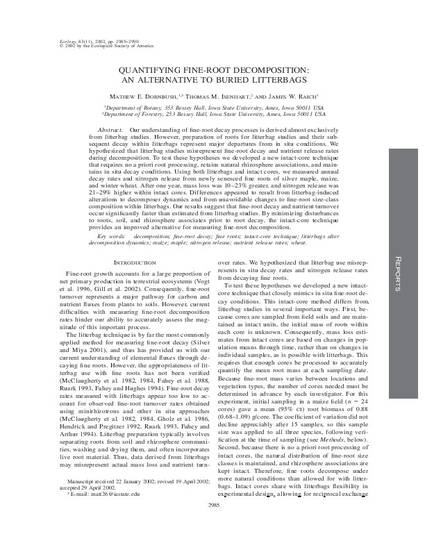
Article
Quantifying Fine-Root Decomposition: An Alternative to Buried Litterbags
Ecology
Document Type
Article
Disciplines
Publication Version
Published Version
Publication Date
11-1-2002
DOI
10.1890/0012-9658(2002)083[2985:QFRDAA]2.0.CO;2
Abstract
Our understanding of fine-root decay processes is derived almost exclusively from litterbag studies. However, preparation of roots for litterbag studies and their subsequent decay within litterbags represent major departures from in situ conditions. We hypothesized that litterbag studies misrepresent fine-root decay and nutrient release rates during decomposition. To test these hypotheses we developed a new intact-core technique that requires no a priori root processing, retains natural rhizosphere associations, and maintains in situ decay conditions. Using both litterbags and intact cores, we measured annual decay rates and nitrogen release from newly senesced fine roots of silver maple, maize, and winter wheat. After one year, mass loss was 10–23% greater, and nitrogen release was 21–29% higher within intact cores. Differences appeared to result from litterbag-induced alterations to decomposer dynamics and from unavoidable changes to fine-root size-class composition within litterbags. Our results suggest that fine-root decay and nutrient turnover occur significantly faster than estimated from litterbag studies. By minimizing disturbances to roots, soil, and rhizosphere associates prior to root decay, the intact-core technique provides an improved alternative for measuring fine-root decomposition.
Copyright Owner
Ecological Society of America
Copyright Date
2002
Language
en
File Format
application/pdf
Citation Information
Mathew E. Dornbush, Thomas M. Isenhart and James W. Raich. "Quantifying Fine-Root Decomposition: An Alternative to Buried Litterbags" Ecology Vol. 83 Iss. 11 (2002) p. 2985 - 2990 Available at: http://works.bepress.com/jim_raich/12/

This article is from Ecology 83 (2002): 2985, doi:10.1890/0012-9658(2002)083[2985:QFRDAA]2.0.CO;2. Posted with permission.